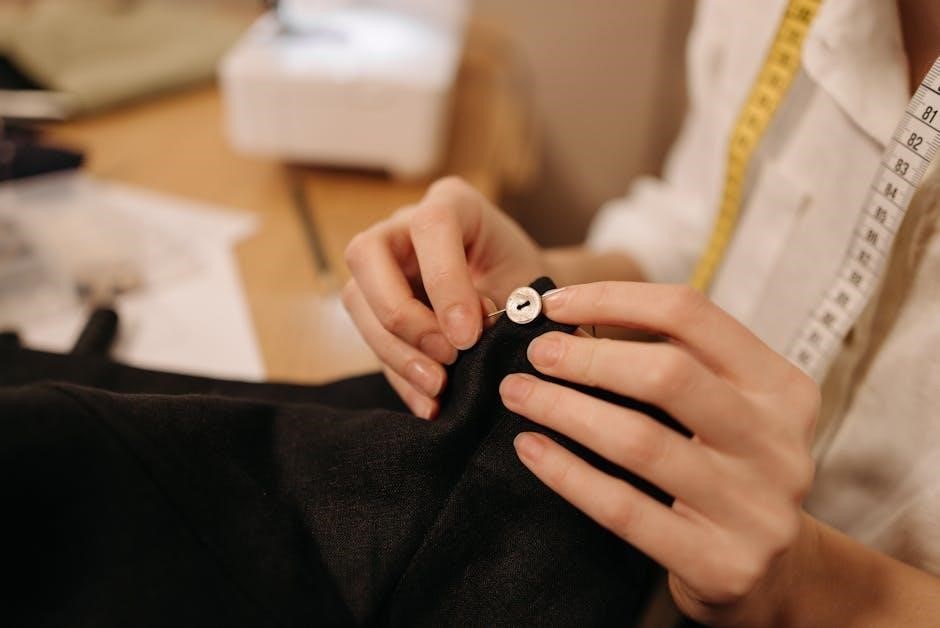minifreak manual
Welcome to the MiniFreak manual, your comprehensive guide to mastering Arturia’s powerful hybrid synthesizer. This manual covers features, operations, and tips for optimal sound design and performance.
Overview of the MiniFreak Synthesizer
The MiniFreak is a versatile hybrid synthesizer combining analog and digital elements. It features a 6-voice polyphony, extensive modulation options, and a user-friendly interface. The synthesizer supports multiple waveforms and algorithms, including Virtual Analog, Wavetable, FM, and Granular synthesis. With its robust connectivity options, including MIDI, USB, and stereo audio outputs, the MiniFreak seamlessly integrates into any studio setup. Its intuitive design and advanced features make it ideal for both beginners and experienced musicians, offering endless creative possibilities for sound design and performance.
Importance of the Manual for Optimal Usage
This manual is essential for unlocking the MiniFreak’s full potential. It provides detailed instructions on setup, operation, and advanced features, ensuring users can navigate the synthesizer’s capabilities confidently. By following the guide, musicians can optimize their workflow, explore creative sound design, and troubleshoot common issues. The manual also covers registration, firmware updates, and preset management, helping users maintain and enhance their instrument. Whether you’re a novice or an expert, this resource is key to mastering the MiniFreak and achieving professional-grade results in your music production.
Setting Up the MiniFreak
Setting up the MiniFreak involves powering it with the provided adapter, connecting to external devices, registering the instrument, and updating firmware for optimal performance.
Powering the MiniFreak
The MiniFreak requires an external power adapter provided by Arturia. Use only the supplied adapter to avoid damage. Connect the power supply before linking other devices. Ensure the unit is powered off when making connections to prevent damage. Arturia recommends using shielded audio cables under 3 meters for optimal performance. Always power down before changing settings or updating firmware. Proper power management ensures stable operation and protects your synthesizer from potential harm. Follow these guidelines to maintain your MiniFreak’s functionality and longevity.

Connecting to External Devices
Connect the MiniFreak to your studio using its rear-panel inputs and outputs. It features MIDI In/Out/Thru, USB Type B for class-compliant MIDI, and a 1/4-inch sustain pedal input. The stereo audio outs and mono audio in enable seamless integration with other gear. Use shielded cables for optimal signal quality. Ensure all devices are powered off before making connections to prevent damage. The MiniFreak’s versatile connectivity options make it a central hub in your music production setup, allowing for easy integration with synthesizers, drum machines, and DAWs.
Registering the Instrument
Register your MiniFreak as soon as possible to unlock its full potential. Upon purchase, you receive a serial number and unlock code, essential for online registration. Visit the Arturia website, log in to your account, and enter the provided details. Registration ensures warranty coverage, access to the MiniFreak V software, and future firmware updates. This step also enables DAW integration and preset management, enhancing your creative workflow. Follow the on-screen instructions carefully to complete the process and enjoy seamless functionality with your MiniFreak synthesizer.
Updating Firmware
Keeping your MiniFreak up-to-date ensures optimal performance and access to new features. Use the MiniFreak V software to check for firmware updates. If an update is available, the software will prompt you with a pop-up. Choose either automatic update via the “Download & Install” button or manual update using the “Update from File” option. Regular firmware updates enhance functionality, fix issues, and add new capabilities. Always update via Arturia’s official channels to maintain stability and unlock the full potential of your synthesizer.

Exploring the MiniFreak’s Features
The MiniFreak is a hybrid analog/digital synthesizer offering a modulation matrix, analog filters, dual LFOs with LED indicators, and touch strips for arpeggiator control. Its rear panel provides MIDI, USB, and audio connectivity, making it versatile for studio integration.
Front Panel Overview
The MiniFreak’s front panel is your command center for sound design and performance. It features a modulation matrix for routing sources to destinations, an analog filter with resonance and cutoff controls, and dual LFOs with waveform shaping. LEDs above the LFOs indicate activity, while the touch strips offer intuitive control over arpeggiator parameters. The Mode button cycles through polyphony types, and the Sound Edit/Utility button unlocks deeper sound-shaping options. The Save button ensures your creations are preserved, making the front panel a hub for both creativity and practicality.
Rear Panel Inputs and Outputs
The MiniFreak’s rear panel offers a variety of connectivity options. It includes MIDI In/Out/Thru ports for seamless integration with other gear, a USB Type B connector for computer communication, and a sustain pedal input for expressive control. Stereo audio outputs provide high-quality sound, while a mono audio input allows for external signal processing. Additionally, the rear panel features a headphone output for private monitoring. These connections ensure the MiniFreak is versatile and ready to integrate into any studio or live performance setup, enhancing your creative workflow with ease and flexibility.
Modulation Matrix
The Modulation Matrix is a powerful tool for creating dynamic sound interactions. Located at the top of the MiniFreak, it allows you to connect various modulation sources to destinations, enabling complex routings. Sources like LFOs, envelopes, and external inputs can control parameters such as oscillators, filters, and effects. This matrix offers deep customization, letting you shape sounds with precision. By routing modulations creatively, you can achieve evolving textures and unique sonic landscapes, making the MiniFreak a versatile instrument for sound design and performance.
Analog Filter
The Analog Filter on the MiniFreak is renowned for its warm, rich timbre, adding depth to digital oscillators. With a twist of a knob, it shapes sounds with character, offering smooth transitions and resonance. This filter enhances harmonic content, providing a classic analog feel to your synthesis. Its intuitive design allows for precise control, making it a key element in crafting distinctive tones. Whether subtle adjustments or dramatic sweeps, the Analog Filter is a cornerstone of the MiniFreak’s sound-shaping capabilities.

LFOs and Their Functions
The MiniFreak features two LFOs (Low Frequency Oscillators) that add dynamic movement to your sounds. These LFOs can be used to modulate various parameters such as pitch, amplitude, and filters. The LFOs offer a range of waveform shapes, including sine, square, triangle, and random, allowing for diverse modulation effects. LEDs above the LFO section indicate their activity, with colors changing based on polarity. You can synchronize LFOs to external clock signals or set them to free-run for rhythmic interest. Additionally, the LFOs can be shaped and routed through the modulation matrix, enabling complex, evolving textures and patterns.

Digital Oscillators
The MiniFreak’s digital oscillators offer diverse synthesis types, including virtual analog, wavetable, FM, formant, granular, and noise. These oscillators provide rich, dynamic sound generation capabilities.
Virtual Analog Oscillator
The Virtual Analog Oscillator in the MiniFreak emulates classic analog synthesis, offering waveforms like sine, sawtooth, and square. It provides a warm, nostalgic sound with precise control over shape and modulation, allowing for smooth transitions and rich textures. This oscillator is ideal for creating deep basses, vibrant leads, and evolving pads, making it a versatile foundation for any sound design. Its intuitive interface ensures seamless integration with the MiniFreak’s modulation matrix for dynamic soundscapes.
Wavetable Oscillator
The Wavetable Oscillator in the MiniFreak offers a rich, dynamic sound design experience. It allows seamless morphing between wavetables, creating evolving textures and complex timbres. With a wide range of wavetable shapes, this oscillator is perfect for crafting unique, otherworldly sounds. The MiniFreak’s display provides real-time visual feedback of the wavetable’s shape and morphing process. Additionally, the ‘Freak Out’ mode introduces random variations, adding an element of unpredictability to your sound design. This oscillator is a key tool for creating modern, experimental, and atmospheric sounds with ease.
FM Synthesis Oscillator
The FM Synthesis Oscillator in the MiniFreak brings the classic sound of frequency modulation to your fingertips. This oscillator allows you to create bright, percussive, and dynamic sounds by modulating one oscillator’s frequency with another. With four-operator FM capabilities, you can design intricate timbres reminiscent of iconic ’80s synths. The MiniFreak’s intuitive interface simplifies the process of routing and adjusting modulation sources and destinations, making it easy to experiment with complex FM algorithms. This oscillator is perfect for crafting sharp, metallic, and evolving sounds that add depth to your music.
Formant Oscillator
The Formant Oscillator in the MiniFreak generates rich, vocal-like tones by simulating the acoustic characteristics of human speech. It uses formant frequencies and their intervals to create harmonically complex sounds. With controls for interval, formant frequency, and formant width, you can shape everything from soft, whispery textures to sharp, percussive articulations. This oscillator is ideal for crafting unique, organic sounds that mimic vocal qualities, adding a human touch to your music. Experiment with modulation sources to create dynamic, evolving formant shifts for captivating results.
Granular Synthesis Oscillator
The Granular Synthesis Oscillator in the MiniFreak is a versatile tool for creating unique, textured sounds. It processes audio by breaking it into micro-samples called grains, allowing for intricate sound manipulation. Key parameters include grain size, density, and scattering, which can be adjusted to craft sounds ranging from smooth, ambient pads to chaotic, experimental textures. By modulating these parameters, users can achieve dynamic, evolving timbres that add depth and interest to their music. This oscillator is perfect for those seeking unconventional sonic possibilities.
Noise Oscillator
The Noise Oscillator in the MiniFreak provides a variety of noise types, including particle noise, to add organic textures to your sounds. Particle noise is created by sampling noise and adjusting the sample rate, offering unique timbres. This oscillator is ideal for creating natural, ambient layers or percussive elements. By experimenting with its parameters, you can craft sounds that range from subtle, atmospheric textures to dynamic, chaotic effects. The Noise Oscillator enhances your sound design capabilities, allowing for rich, organic tones that complement the MiniFreak’s digital and analog synthesis features.
Modulation and Control
The MiniFreak offers extensive modulation and control options, including a modulation matrix, envelope generators, LFOs, and touch strips, enabling deep sound shaping and dynamic performance control.
Modulation Matrix Configuration

The Modulation Matrix allows you to connect sources and destinations, creating complex modulation routings. Sources include LFOs, envelopes, and external inputs, while destinations can be oscillators, filters, or effects. This matrix enables dynamic control over various parameters, offering deep sound-shaping capabilities. Users can assign multiple sources to a single destination or spread modulations across several parameters for rich, evolving textures. The matrix interface is intuitive, making it easy to experiment and create unique sonic interactions. This feature is central to unlocking the MiniFreak’s creative potential for sound design and performance.

Envelope Generators
The MiniFreak features powerful envelope generators that shape sound parameters over time. These envelopes can be assigned to control amplitude, filters, pitch, and more, offering precise control over dynamic changes. With multiple envelope types and adjustable stages, users can create complex, evolving textures. The interface allows for intuitive configuration, enabling seamless integration into sound design workflows. Envelopes can also be looped for sustained effects, adding depth and versatility to your creations. This feature is essential for crafting expressive, dynamic sounds that stand out in any musical context.
LFO Waveform Shaping
The MiniFreak’s LFOs offer extensive waveform shaping capabilities, allowing users to craft dynamic, evolving sounds. The LFO section features LED indicators that pulse according to the LFO rates, with color changes reflecting positive and negative modulation. Users can shape waveforms using dedicated knobs, creating unique modulation patterns. The display provides real-time feedback, showing waveform adjustments and numerical values. With support for various waveforms and synchronization options, the LFOs enable precise control over oscillators, filters, and other parameters, making them a key tool for creating rich, textured soundscapes.
Touch Strips Functionality
The MiniFreak’s touch strips provide intuitive control over various parameters, enhancing real-time interaction. They can be assigned to control Gate time and Spice in the Arpeggiator and Sequencer modes, with orange LEDs indicating their active state. Shift-touching the Seq/Arp button enables the Dice feature, adding randomization to your sequences. The touch strips offer a dynamic way to shape sounds and rhythms, allowing for expressive modulation and parameter adjustments on the fly. This feature adds a tactile dimension to sound design and performance, making the MiniFreak a versatile tool for both studio and live use.

Arpeggiator and Sequencer
The MiniFreak’s Arpeggiator and Sequencer offer powerful tools for creating dynamic patterns and melodies. Explore modes, operations, and modulation sequence lanes to craft unique sounds and rhythms effortlessly.
Arpeggiator Modes
The MiniFreak’s arpeggiator offers versatile modes to shape your sound. Choose from Monophonic, Polyphonic, Paraphonic, and Unison modes, each delivering unique tonal textures. Monophonic mode plays one note at a time, while Polyphonic handles chords with ease. Paraphonic mode allows each note to have its own envelope, and Unison stacks voices for a bold sound. Explore these modes to create dynamic arpeggios, from simple sequences to complex, layered patterns. The arpeggiator also features adjustable note order and octave range, giving you full control over your musical ideas.
Sequencer Operations
The MiniFreak’s sequencer allows you to create and edit complex musical patterns. It supports real-time recording, enabling you to capture ideas as they emerge. Step editing provides precise control over note placement, timing, and velocity. The sequencer also integrates with the modulation matrix, allowing dynamic changes in sound parameters. With the ability to assign modulation lanes, you can add depth and movement to your sequences. This powerful tool is designed to inspire creativity and streamline your workflow, making it an essential part of your sound design process.
Modulation Sequence Lanes
Modulation sequence lanes in the MiniFreak allow you to create dynamic, evolving sounds by assigning modulation patterns to specific parameters. These lanes can be used to control LFOs, envelopes, or other sources, enabling intricate variations in your sequences. With the ability to draw or edit modulation curves, you can achieve precise control over how your sounds evolve. This feature enhances the sequencer’s functionality, offering a deeper layer of creativity and expression in your music production. It’s a powerful tool for crafting unique and engaging musical ideas.
Effects and Processing
The MiniFreak features a range of built-in effects, including Chorus, Delay, and Reverb, to enhance your sounds. These effects can be easily accessed and adjusted via the MiniFreak V software.
Built-in Effects Overview
The MiniFreak is equipped with a versatile suite of built-in effects, including Chorus, Delay, and Reverb, designed to enhance and expand your sound design capabilities. These effects can be seamlessly integrated into your patches, offering depth and texture to your creations. The Chorus effect adds width and richness, while the Delay provides rhythmic interest and spatiality. Reverb further enhances your sounds with immersive, atmospheric qualities. These effects are easily accessible and adjustable via the MiniFreak V software, allowing for real-time tweaking to achieve the perfect sonic balance.
Chorus and Delay Effects
The MiniFreak’s Chorus and Delay effects offer dynamic sound-shaping tools. The Chorus effect creates rich, wide soundscapes by layering detuned copies of your signal, adding depth and movement. The Delay effect provides rhythmic and spatial possibilities, with adjustable timing and feedback for creating echoes, loops, or ambient textures. Both effects are intuitive to use, allowing you to enhance your sounds with precision and creativity, making them essential for crafting unique and engaging musical elements directly within the MiniFreak’s interface.
Reverb and Other Effects
The MiniFreak’s Reverb effect adds spatial depth to your sounds, simulating environments like rooms, halls, or plates. Adjust parameters such as room size, damping, and level to tailor the ambiance. Beyond Reverb, the MiniFreak offers a variety of other effects, including distortion, phaser, and EQ, to further shape and enhance your sound. These effects can be layered or used individually, providing endless possibilities for creative sound design and experimentation, making the MiniFreak a versatile tool for crafting unique sonic landscapes with precision and ease.

Preset Management
The MiniFreak allows seamless preset management, enabling you to save, load, and organize your custom sounds effortlessly. With 512 onboard slots, you can store and recall your unique patches, ensuring your creative workflow remains efficient and intuitive.
Saving and Loading Presets
Saving and loading presets on the MiniFreak is straightforward, allowing you to store and recall your custom sounds with ease. To save a preset, press the Save button, which will prompt you to choose a slot or overwrite an existing one. The MiniFreak features 512 onboard preset slots, providing ample space for your creations. When loading a preset, navigate through the browser using the knobs or buttons to find and select your desired sound. The Utility menu also offers options like Preset Init and Reload Preset for further customization and management of your sounds.
Organizing Presets
Organizing presets on the MiniFreak is designed to be intuitive and efficient. The browser allows you to navigate through presets using knobs or buttons, with options to filter by type, designer, or revision number. You can also use the Utility menu to manage preset operations, such as reloading or initializing presets. This system ensures that your sounds are easily accessible and customizable, making it simple to maintain a well-organized library of unique and inspiring patches for your music production needs.
Utility Menu Functions
The Utility menu on the MiniFreak offers essential tools for customizing and maintaining your synthesizer. It provides options for control and navigation, allowing you to adjust MIDI settings, sync parameters, and manage system preferences. The menu also includes preset operations, enabling you to initialize, reload, or organize your sounds efficiently. Additionally, it offers firmware update options, ensuring your MiniFreak stays up-to-date with the latest features and improvements. These functions make it easier to personalize your workflow and maintain optimal performance while creating music.
Advanced Techniques
Explore advanced techniques for the MiniFreak, focusing on creative modulation routing and firmware updates to unlock deeper sound design possibilities and enhance your musical creations.
Using the Modulation Matrix Creatively
The Modulation Matrix is a powerful tool for creating dynamic, evolving sounds. By routing sources like LFOs, envelopes, and external inputs to destinations such as oscillator pitch, filter cutoff, or amp level, you can craft intricate soundscapes. Experiment with complex modulations, such as using an LFO to control filter resonance while an envelope shapes the amplitude; For deeper textures, try layering multiple modulations or using the Cycling Envelope to create looping patterns. This matrix opens endless possibilities for creative sound design and performance, making your MiniFreak truly unique.

Layering Sounds
Layering sounds on the MiniFreak allows for rich, complex textures. Combine the Virtual Analog, Wavetable, and FM oscillators to create deep, evolving timbres. Use the analog filter to blend layers seamlessly, adding warmth and cohesion. Experiment with the Chorus and Delay effects to enhance depth and space. For dynamic performances, assign each layer to a separate MIDI channel, enabling independent control. This approach unlocks the MiniFreak’s full sonic potential, making it ideal for crafting unique pads, leads, and ambient soundscapes.
Firmware Updates
Regular firmware updates ensure the MiniFreak operates at its best. Use the MiniFreak V software to check for updates automatically. Click the “Download & Install” button for the latest version or use “Update from File” for manual updates. Firmware updates add new features, improve performance, and fix bugs. Always update to access the latest enhancements and maintain compatibility with your setup. Visit the Arturia website or use the Arturia Software Center for the most recent updates, ensuring your MiniFreak stays up-to-date and fully functional.
The MiniFreak manual guides you through mastering Arturia’s hybrid synthesizer, empowering you to unlock its full creative potential. Explore, experiment, and enjoy crafting unique sounds with this versatile instrument.
The MiniFreak is a versatile 6-voice hybrid synthesizer, blending analog and digital elements. It features a range of oscillator types, including virtual analog, wavetable, FM, and granular synthesis. The analog filter adds warmth and character, while the modulation matrix offers deep control over sound shaping. With built-in effects, arpeggiator, and sequencer, the MiniFreak is ideal for both studio and live performances. Its intuitive interface, touch strips, and robust preset management system make it a powerful tool for sound designers and musicians alike, ensuring endless creative possibilities.
Final Tips for Mastering the MiniFreak
Experiment with the modulation matrix to unlock unique soundscapes. Regularly update firmware for the latest features and improvements. Explore the touch strips for dynamic control over parameters. Save and organize presets to streamline your workflow. Dive into the arpeggiator and sequencer for complex rhythmic patterns. Don’t hesitate to use the utility menu for fine-tuning settings. Practice layering sounds to create rich, textured compositions. Most importantly, embrace the MiniFreak’s versatility and let your creativity guide your sound design journey.
